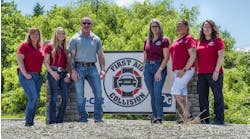The aftermarket as a whole has "flexibility in work hours, unlimited income potential and a demand for workers to fill jobs, all of which is very attractive to young people," says Karen Bryson, human resources director with The Pep Boys — Manny, Moe and Jack. But the industry, like many others, is struggling to recruit new employees with modern-day skills.
Fewer jobs and higher unemployment rates have created a larger pool of potential employees, but fewer are entering the aftermarket each year.
"It is really a very viable opportunity, but there is a smaller pool of students entering the industry," says Jim John, chair of the Aftermarket Management Department at Northwood's University of the Aftermarket. "The recent news — the big three being in dire financial trouble — doesn't do the industry any good. It is hard to convince mom and dad that their youngsters ought to be involved."
Even when potential employees willingly pursue the aftermarket, they often are faced with much higher expectations than seen in years past. There are a lot of newer, preferred qualifications, like a college degree and advanced computer, math and language skills, requirements not often needed 10 or 20 years ago, says Jack Creamer, president of Distribution Marketing Services, a Phoenix-based executive recruiter and marketing service provider.
"It used to be if a male high school student wasn't excelling in English or math, they would put him on the vocational track. Back then it was perfect. Today it is not," says Robert Joshlin, president of Speedway Auto Parts in Indianapolis, Ind. "We need the same people as other industries — ones that are extremely qualified and capable of learning, advancing and understanding, as the automotive field is much more technical than it once was."
And even when trained and qualified young people approach the aftermarket, they often must undergo an interview process that is exceedingly evaluative and analytical of personality, temperament and potential, Creamer says. "People are looking for that perfect new employee using outside resources like psychological testing, personality profiles and other skill evaluations, like computer skills," he says. "For every dollar you put out there in salary, you are putting another dollar out in recruitment and hiring costs. With the cost of hiring someone today, it makes a mistake too expensive."
So how are companies staying ahead?
Recruitment 101
Despite a somewhat gloom and doom outlook, many companies continue to maintain successful recruitment programs. What are they doing right?
"Years ago, it was very easy to look through a stack of resumes and find what you needed. But now, you need to target this generation," says Troy Fee, Pep Boys' senior vice president of human resources. "We participate in all of the usual areas you would imagine: on job boards, through Internet sites. We also work with the schools to target and get young technicians."
A business's reputation and values also play a role. "It is company specific. If you are a good company with good people, the public will know you and understand what you are about. It is all about providing the best environment for your employees," Fee says.
A satisfied workforce will return the best recruitment tool — word of mouth. "The person I love to hire is someone that comes with a recommendation from a current employee, has the right training and great work ethic," Fee says.
Greg Wintroub, president of independent warehouse distributor All Products Automotive, Inc. (APA) in Chicago, Ill., also relies on his employees to be his personal promoters. "We have an excellent reputation and a lot of employees hear about us through word of mouth," he says. "And internally, we promote from within."
The industry as a whole has recruited more than 1,000 students through its scholarship program, primarily supported through the Global Automotive Aftermarket Symposium. "The program has given out more than 1,000 scholarships over the past 10 years. That is 1,000 people who have been exposed to the aftermarket and immediately become a pool of potential employees," Creamer says.
Using methods like the scholarship program helps to attract the attention of young people early on, enabling the aftermarket to be in the forefront as future career paths are being planned. Wintroub promotes available jobs and his company through visits to local university and college programs. But the industry needs to take it a step further, he says.
"We have to go to the college sector and say, 'We have jobs.' We need to talk about what careers are available in the industry," says Wintroub.
Untapped potential
While tried and true recruitment methods are bringing new employees to the industry, albeit not always at the pace hoped for, the aftermarket has plenty of room to grow.
A lack of exposure and advertising to the younger generation and current students is a key missed opportunity to attract more employees, Wintroub says.
"We have just not done enough to advertise to make the industry seem glamorous. We are not selling ourselves as a progressive, 2008 industry. We have a lot of gray hair at the senior management level, and we have an old image," he says. "We need to be out there talking about the options in the industry, talking about pay levels, computers, information technology. We need to talk about the drive-by wire and the kinds of things that are going to happen with the car becoming an extension of a person through technology, because this industry can be just as exciting as any other."
Informing the public about the industry is important — but how that information is presented will make the difference in the younger generation's interpretation of the aftermarket, Bryson says.
"We need to keep up with the times. We need to approach young people with more technical savvy to keep them interested," she says.
Catching the attention of students and young people can be very challenging, John says. Presentation is everything. "I guess the students are like all of us. Their attention span is somewhat limited. You need to tell them something exciting about your products or service to whet their appetite," he says.
Internship and apprenticeship opportunities allow students to have a small taste of a job and its duties, while also becoming familiar with a company's inner workings on a short-term basis. The University of the Aftermarket mandates students complete a 10-week internship before graduation, and the requirement often opens doors for full-time employment in the future.
But the task of bringing on younger and brighter staff should not be the only recruitment focus in the aftermarket, says Joshlin. "I think one of our toughest jobs is not always recruiting the young and the new, but maintaining the older employees and keeping them in our industry," he says.



